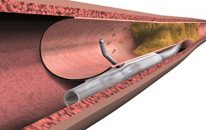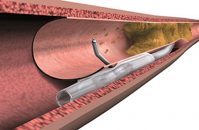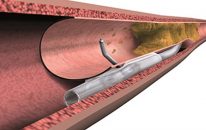Courtesy of the SBHCI. Chronic stable angina and severe coronary lesion patients who undergo angioplasty in a single vessel show no better outcomes than individuals who undergo a placebo sham procedure when it comes to exercise capacity and symptoms, according to this study presented at TCT and published simultaneously in the Lancet. The curious results…
Should We Begin to Use IVUS in CTO?
Courtesy of Dr. Carlos Fava. Currently, chronic total occlusions (CTO) are one of the obstacles that coronary angioplasties must overcome, particularly with the development of drug-eluting stents (DES) and new devices and strategies for these challenging lesions. However, there is little information on the safety, efficacy, and real clinical benefit of implanting stents of over 60 mm (known as full metal jackets, FMJ).…
SOLACI CACI 2017 | Re-entry approach to CTO
Read articles on the main presentations of the third day of SOLACI-CACI 2017 Congress. See the presentation by Dr. Luiz Fernando Ybarra, entitled “Re-entry approach to CTO”. We are interested in your opinion. Please, leave your comments, thoughts, questions, etc., below. They will be most welcome.
Clinical Significance of Collaterals in Chronic Total Occlusions
Collateral circulation develops during the gradual progression of coronary occlusions in order to replace the original artery and supply blood to areas jeopardized by ischemia. However, the relevance of collaterals has remained controversial for many years. Several works have suggested a rapid regression of collaterals after rechanneling of chronic total coronary occlusions, which could render…
Successful CTO reduces local and remote residual ischemia
Courtesy of Dr. Carlos Fava. The presence of Chronic Total Occlusion (CTO) is about 30%, with an ischemic threshold between 10% and 12.5% to justify rechannelization. Using the new devices, the new guidelines and with more experience operators, these procedures are successful in 10% to 30% of cases. More often than not these patients are not treated…
CTO in patients with acute myocardial infarction increases long term mortality
Courtesy of Dr. Carlos Fava. It has been proved that in a setting of acute myocardial infarction with multivessel lesions, only the culprit vessel must be treated (if there is no hemodynamic compromise) at first, and other severe lesions are to be treated during a second session. However, proper conduct in cases with presence of chronic…
Successful angioplasty in elderly patients with chronic total occlusion reduces mortality
Courtesy of Dr. Carlos Fava. Nowadays, the number of coronary angioplasties carried out on patients with chronic total occlusion (CTO) is increasing due to many studies showing that it improves ventricular function, reduces symptoms, and improves survival. However, most of these works do not include patients of over 75 years old due to their frailty and…
DECISION-CTO: Prevailing Questions on CTO Rechanneling
The first and only randomized trial on chronic total occlusion (CTO) revascularization versus optimal medical therapy in stable patients has disappointed interventional cardiologists. According to Dr. Seung-Jung Park, who presented the study, evidence suggests that optimal medical therapy is a reasonable initial treatment strategy for chronic total occlusion, when compared with angioplasty. Critics…
Is The Transradial Approach Useful in CTO?
Courtesy of Dr. Carlos Fava. The transradial approach has been advanced in time, and is being increasingly used in more and more complex angioplasty procedures with the same benefit, compared to the classical femoral approach. As a result, in many high volume centers, this reality has demoted the femoral approach to a few particular procedures.…
Rechanneling a CTO in a Non-Infarct-Related Artery After Primary PCI: Yes or No?
Between 10% and 15% of patients admitted with ST-segment elevation myocardial infarction present concurrent coronary chronic total occlusion (CTO) in a non-infarct-related artery, which is associated with increased morbidity and mortality. The EXPLORE (Evaluating Xience and Left Ventricular Function in Percutaneous Coronary Intervention on Occlusions After ST-Elevation Myocardial Infarction) trial evaluated whether patients admitted…









